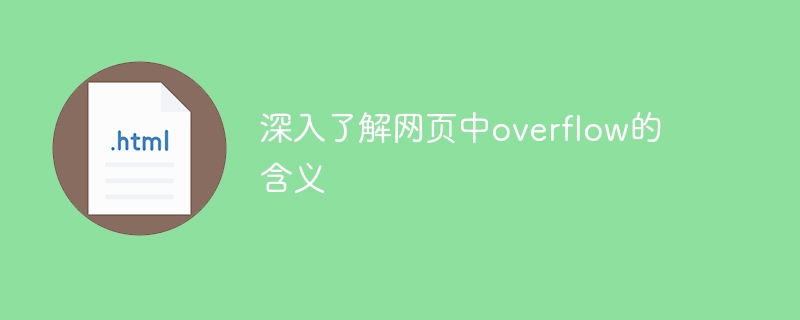

In-depth understanding of the meaning of overflow in web pages requires specific code examples
In web development, we often encounter situations where some content overflows, that is, the content exceeds its limit. The visible area of the container, then you need to use the CSS property overflow to control the display mode of the content. This article will delve into the meaning of the overflow attribute and specific code examples.
1. The meaning of the overflow attribute
The overflow attribute is used to specify how to handle overflow content when the content of an element exceeds its specified size. It has the following values:
2. Example of overflow attribute
Let’s learn more about the usage of overflow attribute through specific code examples.
<!DOCTYPE html>
<html>
<head>
<style>
.container {
width: 200px;
height: 200px;
border: 1px solid black;
overflow: hidden;
}
.content {
width: 300px;
height: 300px;
background-color: #f1f1f1;
}
</style>
</head>
<body>
<h2>overflow: hidden</h2>
<div class="container">
<div class="content"></div>
</div>
<h2>overflow: scroll</h2>
<div class="container" style="overflow: scroll;">
<div class="content"></div>
</div>
<h2>overflow: auto</h2>
<div class="container" style="overflow: auto;">
<div class="content"></div>
</div>
</body>
</html>In the above example, we created a parent container .container and a child container .content, and used different overflow attributes to control the content. Overflow effect.
The first is an example of overflow: hidden. This attribute will hide the overflow content so that only the content of the specified size is displayed inside the container.
The following is an example of overflow: scroll. This attribute will add scroll bars to the container, and the scroll bars will be displayed regardless of whether the content overflows. Scroll bars allow users to slide content to view.
The last is an example of overflow: auto. The performance of this attribute is similar to overflow: scroll, but the scroll bar is only displayed when the content overflows, otherwise it is not displayed. .
Through these examples, we can clearly see the performance and effect of the overflow attribute in different situations.
Summary:
Through the introduction of this article, we have an in-depth understanding of the meaning and usage of the overflow attribute in web pages, and demonstrated it through specific code examples. In the actual web development process, mastering the overflow attribute is very important for handling the display of overflow content, which can improve the user experience and make the web content more standardized and beautiful.
The above is the detailed content of Learn more about the meaning of the overflow attribute in web pages. For more information, please follow other related articles on the PHP Chinese website!
 Absolute reference input method
Absolute reference input method
 Which mobile phones does Hongmeng OS support?
Which mobile phones does Hongmeng OS support?
 What does a file extension usually mean?
What does a file extension usually mean?
 java regular expression matching string
java regular expression matching string
 How to export project in phpstorm
How to export project in phpstorm
 How to set transparency in CSS
How to set transparency in CSS
 A memory that can exchange information directly with the CPU is a
A memory that can exchange information directly with the CPU is a
 What does it mean that the computer is not supported?
What does it mean that the computer is not supported?
 git pull pulls code
git pull pulls code




